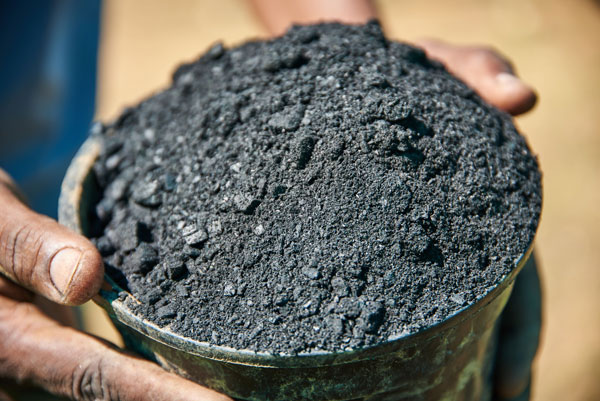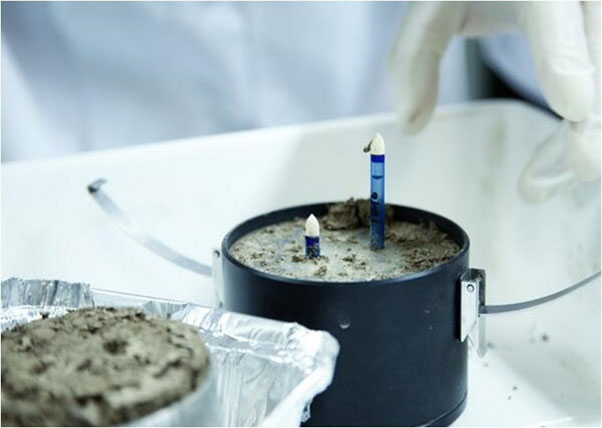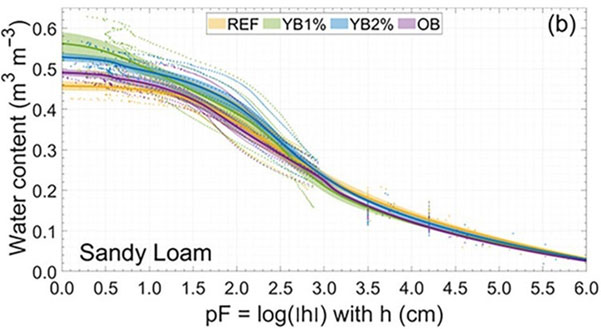Biochar water retention and conductivity curves: a case study

Soil degradation is a widespread issue affecting the efficiency of agricultural production in Australia and New Zealand. Degraded soils have poor water quality characteristics such as low water holding capacity and infiltration. One strategy to improve soil water characteristics is to add biochar (biological charcoal) to degraded sites. A recent scientific publication suggests that biochar can improve soil water retention and hydraulic conductivity characteristics. The result of this research is of great interest to Australian and New Zealand scientists who have long advocated the use of biochar in agriculture.
What is biochar?
Biochar is a form of charcoal made from organic materials like wood or crop residues through a process called pyrolysis. In turn, pyrolysis is a process of heating organic materials in the absence of oxygen. Biochar is rich in carbon and has various uses: improving soil fertility and structure, sequestering carbon to mitigate climate change, filtering water, managing organic waste, and potentially enhancing livestock feed. Biochar enhances soil health, retains water and nutrients, and reduces the need for synthetic fertilisers.
What are soil water retention and hydraulic conductivity curves?
A soil water retention curve, also known as a soil moisture characteristic curve, illustrates the relationship between soil water content and soil water potential. It shows how much water soil can retain at different levels of saturation or tension. The curve typically starts at field capacity, where soil holds its maximum water, and decreases as water drains. It's crucial for understanding soil moisture dynamics, irrigation management, and plant-water relationships in Australian and New Zealand agriculture.
A soil hydraulic conductivity curve describes how easily water moves through soil at different levels of saturation. It illustrates the relationship between soil water content and the rate of water movement through the soil, typically represented as a function of soil moisture tension. This curve helps understand soil drainage characteristics, infiltration rates, and water movement in the vadose zone. It's vital for various applications, including groundwater recharge, flood prediction, irrigation planning, and contaminant transport modelling. Soil hydraulic conductivity curves are used in hydrology, agriculture, environmental engineering, and other fields related to water resources management.
How are soil water retention and conductivity curves measured?
There is a single scientific instrument that can simultaneously measure and create a soil water retention and hydraulic conductivity curve: the HYPROP2 from METER Group (Figure 1).
The HYPROP2 is a state-of-the-art, German engineered and manufactured instrument used to measure soil water retention properties, specifically the soil water retention curve. It employs the evaporation method combined with two high-precision tensiometers to measure the soil water potential at different soil water contents. This allows for the accurate determination of soil water retention characteristics across a wide range of soil types and moisture levels.
The HYPROP2 determines soil hydraulic conductivity by combining the differential measurements from the two tensiometer shafts within the device with Darcy’s law.
Soil water retention and hydraulic conductivity curves are automatically calculated with LABROS SoilView software that is also supported by METER Group.
Figure 1. The HYPROP2 instrument, from METER Group, quantifies soil water retention and hydraulic infiltration curves.
Does biochar improve soil water characteristics?
Recent research, published in Vadose Zone Journal, from scientists at UCLouvain, Belgium, tested the hypothesis that biochar improves soil water characteristics. The research studied many parameters related to soil physical characteristics including water retention and hydraulic conductivity. Interestingly, the research examined young and old biochar where the young biochar was recently created, and the old biochar created over 100 years previous in kilns. The researchers deployed the HYPORP2 instrument to measure soil water retention and hydraulic conductivity curves for soils amended with the young and old biochar.
The results found that young biochar increased saturated water content due to soil structure improvement. “The addition of young biochar to soil reduced the bulk density, increased macroporosity and consequently water content on the wet end of the retention curve (pF < 1.5), and tended to increase the saturated hydraulic conductivity” (page 13, Zanutel et al 2023).
There was no difference in the 100 year old biochar and a control site possibly due to “inaccessible internal porosity of old biochar particles as a result of the clogging of pores by clay particles” (page 17, Zanutel et al 2023).
These results are illustrated in the following figures from Zanutel et al (2023). Figure 2 is a soil moisture retention curve for a sandy loam soil. There are 4 curves displayed on Figure 2: REF, YB1%, YB2%, OB. REF is the control soil without biochar amendment. YB1% and YB2% are young soils with 1% and 2% biochar amendments. OB is the soil amended with 100+ year old biochar. At the wet end of the curve (left-hand side of the graph), it is clearly illustrated that YB1% and YB2% have wetter curves than REF. This demonstrates that biochar amendment can improve water retention at the wet end of the curve.
Figure 2. Soil water characteristic curves for a sandy loam soil amended with young and old biochar. Source: Figure 3b, Zanutel et al, 2023.
Figure 3 is an example of a hydraulic conductivity curve for the same sandy loam soil. The left-hand side of Figure 3 is the wet end of the soil hydraulic conductivity curve. Figure 3 shows that biochar amendment increased hydraulic conductivity at the wet end with the largest differences found for young soils with 1% amendment at the old biochar.
Figure 3. Soil hydraulic conductivity (infiltration) curves for a sandy loam soil amended with young and old biochar. Source: Figure 5b, Zanutel et al, 2023.
Conclusion
In summary, biochar offers a promising solution to mitigate soil degradation in Australia and New Zealand. Recent research indicates its potential to enhance soil water retention and hydraulic conductivity, particularly with young biochar amendments. Utilising state-of-the-art scientific instrumentation, such as the HYPROP2 from METER Group, enhances our understanding of biochar dynamics on soil water characteristics. Further studies are needed to optimize application methods for sustainable agricultural practices.
Further Information
- Zanutel et al., Vadose Zone J. 2024;23:e20301.
- Soil water potential sensors and meters



